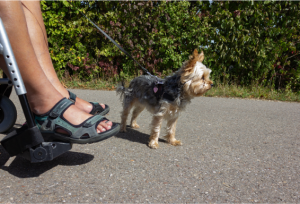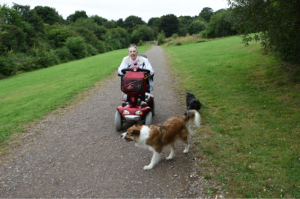Walking Dogs Alongside Wheelchairs, or Mobility Scooters.
It has long been proven that, having a pet, can have a positive effect on a person’s mental and emotional health. However, having a physical disability should not discourage anyone from having a rewarding relationship with a pet of their choice. This Holidays4Dogs article looks at walking dogs alongside wheelchairs, or mobility scooters.
Physical disability need not prevent anyone from enjoying the wonderful experience that having a dog, or other pet, brings.
Taking your dog for daily walks is, of course, important for every dog owner. While this may take a little more time to get organised, it should by no means discourage people with disabilities from owning a dog – or dogs!
Indeed, many dogs will adapt perfectly well to walking with their companion alongside a scooter, or wheelchair. Others, may need to build a little more confidence – but this is often easily achieved.
How should you teach your dog to walk safely alongside a wheelchair, or scooter?
Clicker training is the ideal method to teach a dog to walk safely alongside a scooter, You can learn how easy clicker training your dog can be here. and here.
 Begin working with your dog at home, or in the garden. Use a harness and lead about 4 – 6 feet long. Start by just sitting still. Click and treat for calm behaviour around the wheelchair.
Begin working with your dog at home, or in the garden. Use a harness and lead about 4 – 6 feet long. Start by just sitting still. Click and treat for calm behaviour around the wheelchair.
Also, encourage the dog to stay on one side, or the other. Click and treat for this too. Gradually, start to move the chair, or scooter, forward. Click and treat each time your dog is in the right position.
It may be a good idea to get a helper to hold the lead and walk alongside you to begin with.
Keeping the dog away from the wheels – target training
If your dog is inclined to walk too close to the wheels of the chair, or scooter, you could try target stick training. Use a stick, (a garden cane will do ). Cut it to about 2 – 3 feet long and place a ping pong ball on the end – or, wrap some cloth around to form a pad.
Encourage your dog to use his nose to touch the end of the stick to get a click and a treat. Once he understands this, move the stick forward so he has to follow it to touch it – click and treat. By doing this you are teaching your dog to follow the stick. You can now use the stick as a guide for how far away from the wheels he needs to be. Don’t worry; you won’t need to use this permanently! You can phase out the use of the stick fairly quickly.
Other tips for getting your dog used to walking nicely next to your scooter
-
Discourage your dog from surging ahead, or swapping sides. Once he’s got the hang of this in the house or garden, move on to a distraction free area where you can move along in a straight line and on the flat.
-
Very gradually build up speed; clicking and treating frequently for walking nicely. Rather than feed your dog from your hand, (which will encourage him to come very close to the scooter ), try and drop treats on the ground just in front of him.
-
Practice, makes perfect. The more you practice walking your dog with your mobility scooter, the better your dog will become at walking calmly alongside you.
 Not all dogs may be suitable to learn how to walk well beside a scooter. Toy dogs, for example, may be far too delicate to be close to a moving scooter.
Not all dogs may be suitable to learn how to walk well beside a scooter. Toy dogs, for example, may be far too delicate to be close to a moving scooter.
Large, boisterous dogs may be too much of a handful. Dogs need to be relatively calm, friendly individuals when interacting with other dogs and people. Nervous, or reactive dogs, may also present a much greater challenge.
If you need extra assistance – get in touch with a good dog trainer. You can also try contacting Dog A.I.D a charity that supports people with disabilities to train their pet dogs.
Conclusion
People who need to rely on wheelchairs, or mobility scooters can still walk their dog just as effectively as any able-bodied person. There are, in fact, a few disabled people who provide dog walking services for a living; so there is no reason at all not to get and about with your dog and enjoy the great outdoors.


